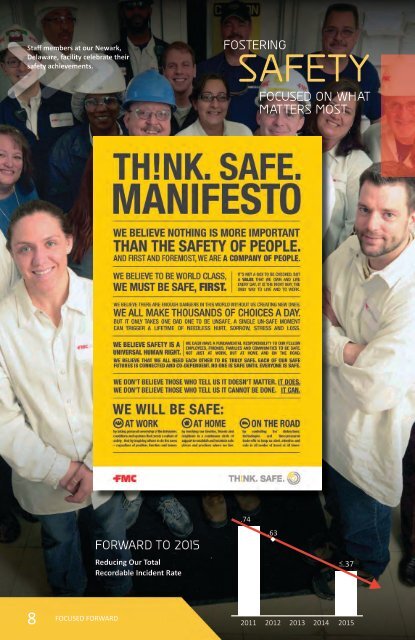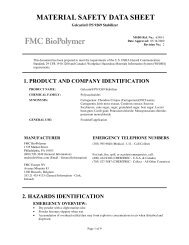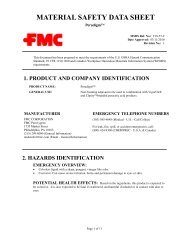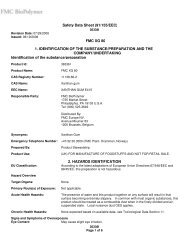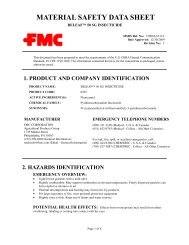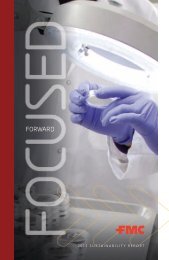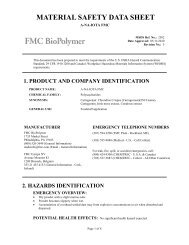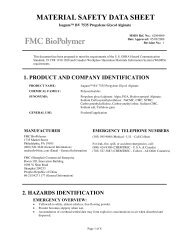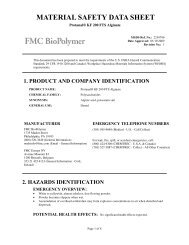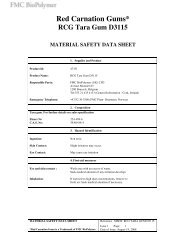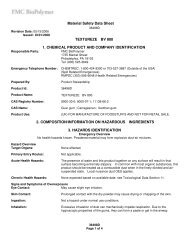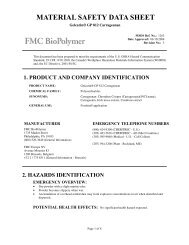SAFETY - FMC Corporation
SAFETY - FMC Corporation
SAFETY - FMC Corporation
You also want an ePaper? Increase the reach of your titles
YUMPU automatically turns print PDFs into web optimized ePapers that Google loves.
Staff members at our Newark,<br />
Delaware, facility celebrate their<br />
safety achievements.<br />
8 FOCUSED FORWARD<br />
FORWARD TO 2O15<br />
Reducing Our Total<br />
Recordable Incident Rate<br />
FOSTERING<br />
<strong>SAFETY</strong><br />
FOCUSED ON WhAT<br />
MATTERS MOST<br />
.74<br />
.63<br />
We believe nothing is more<br />
important than the safety of<br />
people. And first and foremost,<br />
we are a company of people.<br />
The safety of employees, customers, business<br />
partners and the public is one of our most<br />
important core values. We are determined to<br />
achieve an injury-free workplace. We know it will<br />
take time, effective systems, a steady focus and<br />
the total commitment of every employee to make<br />
it happen. As an intermediate target, we will work<br />
to at least halve our Total Recordable Incident Rate<br />
(TRIR) by 2015 compared to 2011. Although this<br />
goal is aggressive, particularly as <strong>FMC</strong> continues to<br />
expand worldwide, it is clear that our employees<br />
are embracing this important challenge.<br />
Safety Performance Status<br />
In 2011, the number of recordable injuries at <strong>FMC</strong><br />
took a disappointing turn. We entered 2012 with<br />
a sense of urgency to assess our safety programs,<br />
refocus employee attentiveness to safety, and<br />
return to a positive trajectory of improvement.<br />
We made significant adjustments to several safety<br />
processes in 2012 to heighten awareness, regain<br />
commitment and provide new tools that help us<br />
track and improve occupational safety.<br />
These changes are already producing positive<br />
results. In 2012, <strong>FMC</strong> improved its TRIR by<br />
15 percent compared to 2011 (see Safety<br />
Performance Indicators in adjacent table). This<br />
demonstrates only part of an important turning<br />
point in 2012.<br />
<strong>FMC</strong> also saw 60 percent fewer recordable<br />
injuries in the second half of 2012 compared to<br />
the first half. Moreover, in January 2013, <strong>FMC</strong><br />
achieved an important milestone: one full month<br />
without a single recordable injury at any of our<br />
sites worldwide. This fact illustrates to all of us<br />
that an injury-free workplace is more than a lofty<br />
idea; it is clearly an achievable reality that we will<br />
relentlessly pursue.<br />
Safety Performance Indicators<br />
Total Recordable Incident Rate<br />
(TRIR)<br />
Lost Workday Case<br />
Incident Rate<br />
A New Era of Safety<br />
Our 2012 safety progress was driven by a new,<br />
coordinated campaign called “Th!nk. Safe.”<br />
This program works to create a culture in which<br />
employees raise their safety consciousness in all<br />
areas of their lives – at work, at home and on<br />
the road.<br />
The program is grounded in a “safety manifesto”<br />
(see image to left) that drives employees to be<br />
aware of their environment and alert to hazards<br />
and behaviors that may affect their own and<br />
others’ safety.<br />
Reviewing Safety Measures<br />
2010 2011 2012<br />
.70 .74 .63<br />
.21 .33 .21<br />
Work-Related Fatalities 0 1 0<br />
Number of Significant Process<br />
Safety Incidents*<br />
0 0 0<br />
* Defined as ACC Tier 1 & 2. For more information visit our<br />
Data Center at www.fmc.com/sustainability<br />
<strong>FMC</strong> reviewed its safety policies, procedures and<br />
systems across all company facilities, sought input<br />
from industry peers, and applied best practices<br />
to revise corporate environmental, health and<br />
safety standards for its global operations. We also<br />
increased communications to share experiences<br />
and effective practices related to safety.<br />
All employees now receive a weekly EHS<br />
newsletter that comes directly from the vice<br />
president of operations. This newsletter includes<br />
performance updates as well as tips and advice<br />
regarding both safety and environmental<br />
awareness.<br />
When an incident does occur, a Learning Review<br />
is conducted with senior management after the<br />
incident investigation is completed. Facts about<br />
the incident, including root causes, contributing<br />
<strong>FMC</strong> 2012 SUSTAINABILITY REPORT<br />
9
At <strong>FMC</strong>, we believe safety<br />
is a value that can only<br />
be real when it becomes<br />
a personal value, an idea<br />
reflected in our new safety<br />
name and logo. TH!NK<br />
SAFE connects every <strong>FMC</strong><br />
employee and relates<br />
the practice of safety to<br />
manufacturing and nonmanufacturing<br />
operations.<br />
causes and key corrective actions, are discussed<br />
and put together in a form that can be shared with<br />
all employees.<br />
Sharing Best Safety Practices Globally<br />
Every quarter our sites now participate in a global<br />
safety conference call to share safety lessons<br />
learned across the company. Site leaders discuss<br />
injuries, near misses, and other experiences that<br />
can help provide insight into measures that can be<br />
taken to prevent similar occurrences elsewhere.<br />
The ultimate goal is to learn from one another’s<br />
experiences and improve our collective safety<br />
awareness and performance.<br />
Our Safety is in Our Hands<br />
In assessing safety throughout <strong>FMC</strong>, we<br />
noticed the most frequent incidents involved<br />
employees’ hands – more than twice the<br />
amount of the next most frequent type of<br />
injury. To address this issue, we instituted<br />
new glove and blade policies in 2012,<br />
providing a list of eight glove types that are<br />
approved for different types of jobs. Since<br />
introducing the new<br />
policies, we have<br />
reduced recordable<br />
injuries to hands by<br />
28 percent over the<br />
previous year.<br />
10<br />
FOCUSED FORWARD<br />
A SYMBOL WITh MEANING<br />
Bold target icon is easily<br />
recognizable.<br />
Broadcast waves<br />
emphasize sharing.<br />
Individual ownership as<br />
central element.<br />
Easy-to-remember name.<br />
Embedded call to action.<br />
During 2012, we established a specific focus on<br />
improving safety among non-manufacturing<br />
employees. While non-manufacturing<br />
environments typically pose lower safety risks<br />
than our production sites, 22 percent of our<br />
2012 recordable injuries occurred at nonmanufacturing<br />
locations. This effort is led by<br />
<strong>FMC</strong>’s executive vice president and general<br />
counsel, demonstrating shared responsibility for<br />
driving safety improvement without functional<br />
or hierarchical boundaries.<br />
Process Safety Performance<br />
Safety is all in the head.<br />
Works in many<br />
languages.<br />
<strong>FMC</strong> has internal definitions for process safety<br />
incidents that are useful for driving improvements<br />
in our operations. Because these definitions<br />
are specific to <strong>FMC</strong>, we have decided to begin<br />
reporting externally in accordance with the more<br />
widely known American Chemistry Council (ACC)<br />
definitions * .<br />
While <strong>FMC</strong> had no significant ACC process safety<br />
incidents to report in 2012, minor incidents did<br />
occur. <strong>FMC</strong> sees all process safety events, even<br />
near misses, as an opportunity to learn. By fully<br />
investigating each event and determining actions<br />
to avoid future occurrences, we will achieve<br />
our safety goals and retain the trust of the<br />
communities surrounding our facilities.<br />
An example occurred on September 9, 2012 at<br />
our Tonawanda, New York, manufacturing plant.<br />
The plant experienced a minor process incident<br />
leading to a small chemical decomposition. Our<br />
plant operators assessed the situation and quickly<br />
followed our response protocol, which included<br />
a request for the fire department to respond. All<br />
chemicals were fully contained. However, some<br />
* More information about data, including definitions, can be found at<br />
www.fmc.com/sustainability/datacenter.aspx
media outlets incorrectly reported that a fire<br />
had occurred.<br />
<strong>FMC</strong> realizes that in this age of social media and<br />
instantaneous information, it is important to<br />
communicate factual information as quickly and<br />
broadly as practical to prevent misunderstandings<br />
and unnecessary concerns. Tonawanda’s incident<br />
investigation identified the need to update <strong>FMC</strong>’s<br />
communication plans in addition to actions that<br />
will prevent future occurrences of this type of<br />
incident.<br />
As a result of this important lesson learned, <strong>FMC</strong><br />
is working to make sure we have the infrastructure<br />
to quickly engage local media to ensure our<br />
local stakeholders have accurate and timely<br />
information. We would be pleased to hear any<br />
other ideas on how <strong>FMC</strong> might communicate with<br />
our surrounding communities. Such ideas can be<br />
emailed directly to sustainability.info@fmc.com.<br />
Food Safety and Supply<br />
In addition to focusing on our own safety, <strong>FMC</strong><br />
provides technologies that contribute to a safe<br />
and sustainable food supply – from increasing crop<br />
yields, to creating more nutritious products, to<br />
removing the need for refrigeration in the supply<br />
chain and protecting food from harmful bacteria.<br />
Too many instances of sickness are caused by<br />
microbial contamination. To address this issue,<br />
<strong>FMC</strong> provides cost-effective solutions that protect<br />
the food supply. These products are highly<br />
effective and break down into environmentally<br />
benign substances, offering a sustainability<br />
advantage over other commonly used antimicrobial<br />
solutions.<br />
In addition to protecting human health, these<br />
products help reduce the amount of food that<br />
goes to waste throughout the supply chain.<br />
Examples of <strong>FMC</strong> microbial products include<br />
the following:<br />
Our Spectrum® program<br />
uses antimicrobial agents<br />
to fight product spoilage<br />
or decay on processed<br />
poultry. Spectrum enables<br />
processors to achieve the<br />
most stringent USDA Tier<br />
1 standards due to its<br />
performance in reducing<br />
pathogenic bacteria<br />
such as Salmonella spp.,<br />
Campylobacter and E. coli.<br />
Aseptic Packaging<br />
Global demand for a wider variety and availability<br />
of consumer beverages packaged for convenience,<br />
shelf life and portability continues to grow. To<br />
ensure freshness and safety, many beverages<br />
must be packaged aseptically to eliminate the<br />
presence and growth of mold and bacteria.<br />
<strong>FMC</strong> has engineered chemistries to respond to<br />
the demands of aseptic packaging processors<br />
worldwide.<br />
Our engineers and scientists developed a<br />
technology that vaporizes peracetic acid (PAA) to<br />
sterilize plastic bottles and cartons in a unique and<br />
highly efficient manner. This technology combines<br />
the benefits of traditional PAA rinse systems with<br />
the latest advancements in hydrogen peroxide<br />
vapor systems, reducing energy costs and water<br />
consumption. The new technology leaves minimal<br />
residue on the filling equipment, resulting in less<br />
production downtime for cleaning and maximizing<br />
the production site’s output efficiency. We believe<br />
adoption of this technology will steadily increase,<br />
particularly in rapidly developing economies.<br />
Product Safety and Stewardship<br />
VigorOx® 15 F&V reduces<br />
decay and spoilage, as well<br />
as pathogenic bacteria on<br />
fruits and vegetables.<br />
Blitz peracetic acid for<br />
red meat provides an<br />
economical solution for<br />
reducing contamination<br />
from pathogenic bacteria,<br />
including E. coli O157:H7<br />
and Listeria monocytogenes.<br />
<strong>FMC</strong> has long supported ACC’s Responsible<br />
Care® program, an industry initiative to improve<br />
environmental, health, safety and security<br />
performance. Over the past two years, <strong>FMC</strong><br />
worked with other ACC members on a strategic<br />
review of the existing Responsible Care program,<br />
which has served the chemical industry well for<br />
more than a quarter century.<br />
<strong>FMC</strong> 2012 SUSTAINABILITY REPORT 11
This collaboration resulted in recommendations<br />
to improve Responsible Care with two new codes<br />
covering product and process safety, both of which<br />
were approved by the ACC at the end of 2012.<br />
Compliance certification for the two new codes<br />
will be phased in from 2014 to 2016.<br />
Training Farmers on Responsible Product Use<br />
<strong>FMC</strong>’s focus on safety extends throughout<br />
the product lifecycle: from design through<br />
development, manufacturing, distribution, storage<br />
and end use. We provide technical and safety<br />
information as well as training at each phase to<br />
foster careful use and stewardship of our products.<br />
Last year alone, our Agricultural Products Group<br />
(APG) trained over 2 million farmers on the<br />
responsible and effective use of our products.<br />
We deliver this training through farmer meetings,<br />
educational materials and technical programs.<br />
APG tailors such efforts to different regions of the<br />
world to focus on the stewardship issues most<br />
pertinent to each locale and to relay messaging<br />
most effectively for the given audience.<br />
For example, in Indonesia, APG aims its safety<br />
training at the importance of backpack sprayer<br />
maintenance and calibration. The program covers<br />
the risks associated with improper maintenance,<br />
the potential economic losses from using too<br />
much or too little product necessary to control<br />
pests and the related potential of crop failures.<br />
These issues resonate with farmers.<br />
12<br />
FOCUSED FORWARD<br />
Across our global workforce, safety is<br />
an everyday practice – at work, at home<br />
and everywhere in between. Wearing the<br />
appropriate safety gear for one’s specific job<br />
function is a fundamental safety practice.<br />
In 2013, <strong>FMC</strong> will focus training on a product<br />
stewardship challenge faced by the entire<br />
agricultural products industry – secure storage<br />
and container management. Proper and secure<br />
storage helps make products accessible only to<br />
those who need to use them for their intended<br />
purpose and helps guard against both unintended<br />
and illegal use. Proper container management<br />
training is important to ensure that after a product<br />
is used, the associated container and packaging<br />
are disposed of responsibly. Training will focus on<br />
the Asia and Latin America markets. Topics will<br />
include how to securely store agricultural products<br />
and the appropriate treatment of used packaging<br />
containers through triple rinsing as well as the<br />
responsible disposal or recycling of used packaging<br />
containers.<br />
During the final quarter of 2012, all <strong>FMC</strong><br />
facilities participated in the ‘Finish Strong’<br />
campaign, an initiative bridging safety and<br />
community engagement. Facilities received<br />
a drawing entry for each month with zero<br />
work injuries. Winners received grants that<br />
were donated to a community cause of their<br />
choice. Our site in Lahore, Pakistan, won the<br />
grand prize, which was used for supplies, staff<br />
salaries and scholarships at three local schools.
Taking Action Against Product Misuse<br />
We closely monitor the end use of our products<br />
and take action when required. In last year’s<br />
report, we discussed the issue of East African<br />
cattle herders misusing our product, Furadan 5G®<br />
granular insecticide, to harm lions that feed on<br />
their livestock. In this particular case we concluded<br />
that our stewardship programs could not<br />
adequately reduce the risk of improper use and we<br />
stopped distribution and sales to Kenya, Uganda,<br />
Tanzania and South Africa, along with taking other<br />
precautionary measures.<br />
Luke Hunter, president of Panthera, the world’s<br />
leading organization devoted exclusively to the<br />
conservation of wild cats and their ecosystems,<br />
recently commented on <strong>FMC</strong>’s management of<br />
Furadan 5G distribution: “I have been greatly<br />
heartened by <strong>FMC</strong>’s response to the ‘Furadan<br />
issue’ in Africa. When it became clear to <strong>FMC</strong>’s<br />
assessors that it was simply impossible to prevent<br />
the misuse of Furadan 5G in remote parts of rural<br />
Africa, the company’s reaction was impressive.<br />
Buying back the product and halting distribution<br />
permanently has effectively removed Furadan<br />
from the equation. Unfortunately, livestock owners<br />
across Africa will always find ways to kill lions<br />
and other carnivores, but <strong>FMC</strong> can be proud that<br />
predators will not die from Furadan poisoning.<br />
<strong>FMC</strong>’s commitment to sustainability goes deeper.<br />
By supporting the Lion Guardians – former lion<br />
killers who are trained as para-biologists to help<br />
their communities avoid conflict with lions – the<br />
company is helping Panthera develop methods to<br />
improve the ability of rural people to co-exist with<br />
carnivores in the long term. So <strong>FMC</strong>’s consistent<br />
support has not only removed the abuse of<br />
Furadan 5G, but also helps target the underlying<br />
reasons why people want to kill lions in the first<br />
place. As a pragmatic, conservation scientist, it<br />
''As a pragmatic, conservation<br />
scientist, it is very gratifying<br />
for me to work with <strong>FMC</strong><br />
on resolving complicated<br />
problems where the needs of<br />
people and wildlife collide.''<br />
Luke Hunter, PhD<br />
President, Panthera<br />
is very gratifying for me to work with <strong>FMC</strong> on<br />
resolving complicated problems where the need<br />
of people and wildlife collide. The <strong>FMC</strong>-Panthera<br />
collaboration is a wonderful model of finding those<br />
solutions.”<br />
Safety Inside and Out<br />
We know we must extend our focus on safety<br />
beyond the way we work and the products we<br />
produce by demonstrating safety leadership in the<br />
communities where we live and operate.<br />
<strong>FMC</strong> employees take pride in applying their<br />
knowledge and skills to make their communities<br />
safer (read more in the Cultivating Community<br />
section). We collaborate with our neighbors on a<br />
range of projects, from producing regional safety<br />
awareness newsletters in Newark, Delaware, to<br />
discussing the importance of safe driving with high<br />
school students in Ungaran, Indonesia, and leading<br />
the sharing of safety guidance and best practices<br />
with neighboring companies in Zhangjiagang,<br />
China.<br />
As our “Th!nk. Safe.” manifesto proclaims:<br />
“We believe we all need each other to be truly<br />
safe. Each of our futures is connected and codependent.<br />
No one is safe until everyone is safe.”<br />
Luke Hunter with colleagues Joel Ziwa<br />
and Mustapha Nsubuga place a radio<br />
collar on a sedated lioness in Uganda.<br />
©Andy Plumptre/WCS<br />
<strong>FMC</strong> 2012 SUSTAINABILITY REPORT 13


